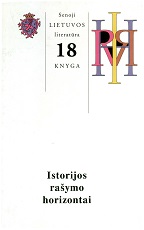Pacai ar Pazzi: nauja Palemono legendos versija LDK ra‰tijoje
PACAS OR PAZZI? NEW INTERPRETATION OF PALAEMON LEGEND IN HISTORICAL LITERATURE OF THE GDL
Author(s): Aušra BaniulytėSubject(s): Literary Texts
Published by: Lietuvių literatūros ir tautosakos institutas
Keywords: Lithuanian noble family Pacas from Italy; the Pacas family related into kinship with the Florentine patrician family Pazzi
Summary/Abstract: In the seventeenth century a tradition to originate Lithuanian noble family Pacas from Italy was born. According to this mythical provenance story, the Pacas family related into kinship with the Florentine patrician family Pazzi, of which one member came to Lithuania with legendary Palaemon and other Roman nobles. Many art historians interpreted this legend and researches of cultural history as phenomenon of cultural orientation of the Pacas family, which influenced their art patronage, based on Italian style Baroque foundations. However, the issue of the Pacas „Italian“ origin in historical literature of the Grand Duchy of Lithuania (henceforth GDL) was not researched by scholars yet, possibly for prevalent opinion in historiography that this tradition did not have written sources and it existed only as oral tradition of this noble family. Therefore, the aim of this article is to analyze the legend of presumed kinship between the Lithuanian noble family Pacas and the Florentine patrician family Pazzi and its source as well as development in historical literature of the GDL. It is supposed that the beginning of presumed kinship between Pacas and Pazzi could started after the treasurer’s and vice-chancellor’s of the GDL Stephen Pacas travel in Italy, when he accompanied the king of Polish-Lithuanian Commonwealth Vladislav the IV in his traveling through the Europe in 1624-1625. During this travel, S. Pacas visited Florence and the House of Cosimo Pazzi as the member of this family accepted him. In Rome during the audience to the Pope, S. Pacas, as the descendant from the House of Pazzi, accepted as well. This experience S. Pacas described in his diary Obraz dworów Europejskich… [The Image of European Courts...]. Probably, the idea about the parentage was based on similar sounding surnames of these noble families as well as of their particular interest in it, otherwise the legend of this presumed kinship did not became so popular. First, for the Pacas this parentage with famous Italian noble family Pazzi helped to overcome the dominant in the GDL Radvilas family as their strongest opponent and to reach the leadership in the political life of the GDL. Meanwhile, for the Pazzi the presumed kinship with the rich Lithuanian noble family was useful as well. This fact testified that one of the members of Pazzi family Lorenzo Domenico de’Pazzi passed to the court of the Pacas and even reached the title of count in royal court of the Polish-Lithuanian Commonwealth under protection of his influential relatives. On the other hand, this supposed kinship was useful for the Medici House because L. D. de’ Pazzi worked as an informer for the court. From the sixteenth century, the Medici aspired to the Polish crown and the ambitions to obtain it they did not lose even in the seventeenth century...
Journal: Senoji Lietuvos literatūra
- Issue Year: 2004
- Issue No: XVIII
- Page Range: 140-168
- Page Count: 29
- Language: Lithuanian

